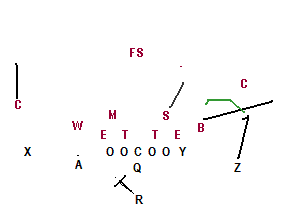The old “smash” concept — with an inside receiver on a corner route behind a quick hitch by an outside receiver — remains one of the most versatile pass plays in football. It’s simple enough that any team, whether they are a run-first team or a passing team, an NFL team or a junior varsity team, can get great use out of it.

It is, of course, best against Cover Two: The purpose is to get a “high/low” vertical stretch on the cornerback.
I’ve also discussed ways to make the concept more useful: One is to use a backside “seam-read” or “divide” routeto threaten the deep safeties.
The other way to get more juice out of the concept is to have the outside receiver run something more like an option route than simply a quick hitch.
Against any coverage, his job is to push to five yards (against soft coverage, it’s a five step route — three big and two quick jab steps to throttle down) and turn his numbers back to the quarterback. And against zones, he just wants to find an open window in the zone coverage, whether it is outside the linebackers towards the sideline or just inside the first zone defender.

Finally, against man coverage some teams like to have the outside receiver run a “whip” or “pivot” route, where they angle inside for five yards and then “whip” back to the sideline. If you are sprinting out to the concept, I like that, but the receiver has to make that read early and as a result he may give away the intention to the corner. And in any event, it’s not an easy throw from a straight dropback. But most of all, to me, the whole point of the smash is to hit the outside unless the defense overplays it, in which case you want to then work back inside. That’s why my favorite adjustment for the outside receiver in smash against man coverage is for him to simply turn it into a delayed slant route.
Indeed, some of the best passing teams do this, and, against “Cover Two Man,” with two deep safeties and man coverage, it is a potentially lethal play.
Instead of running a concept, the smash, where the defense has multiple guys to cover your receivers and eliminating the zone stretch because it’s man, you instead wind up with option routes one-on-one to great athletes: your outside receivers.
Below are two rather dramatic examples of the efficiacy of having those outside receivers run delayed slants against man. In both, watch how the safeties overplay the corner route and how the defensive back cannot cover the receiver with that much empty space. And keep in mind that both of these defenses — the Pittsburgh Steelers in the first clip and Kansas State in the second, are pretty good. (The wide receivers are pretty good though, too.)
